Quanzhou reveals discovery of old Silk Road sites
 0 Comment(s)
0 Comment(s) Print
Print E-mail Xinhua, December 17, 2020
E-mail Xinhua, December 17, 2020
The city of Quanzhou in East China's Fujian province, one of the most important Chinese ports along the historic maritime Silk Road, reported new findings concerning archaeological efforts from 2019 to 2020, experts said at a seminar held in Quanzhou from Friday to Saturday.

The latest research and excavation results on iron-making remains in Quanzhou's Anxi county showed that it previously manufactured large quantities of iron and steel, major commodities of trade along the historic maritime Silk Road, mainly during the Song Dynasty (960-1279) and Yuan Dynasty (1271-1368), says Shen Ruiwen, a professor at the School of Archaeology and Museology of Peking University.
Two other sites were discovered and identified as remains of regulatory bodies that existed within the two dynasties, says Wang Bo, a researcher at the Institute of Archaeology of the Chinese Academy of Social Sciences.
One of them oversaw affairs related to the emperors' kin, and the other served similar functions as today's customs, according to Wang.
"The two ancient institutions showed that Quanzhou once provided valid support for the monarch's reign, especially through ocean trade," An Jiayao, a senior archaeologist, says.
Another finding unveiled was the evolution of china-making technology from the Song Dynasty to the Qing Dynasty (1644-1911) in Dehua county, as is evidenced in the thousands of relics unearthed in the remains of five kilns.
The city is the site of China's only UNESCO World Cultural Heritage application project in 2020 named Quanzhou: Emporium of the world in Song-Yuan China. The project consists of 22 sites of historical relics, including the four that posted new findings at the seminar.
"Quanzhou is one of a kind in historical significance because it preserved the consistent trail of urban planning and construction from the late Tang Dynasty (618-907) to the Qing Dynasty," says Wang.
Experts say the city will continue with excavation on some of the sites included in the project and carry out long-term preservation plans.






Go to Forum >>0 Comment(s)